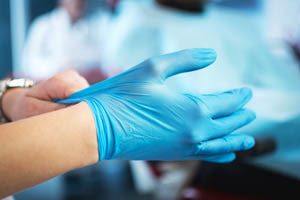Is PPE Safe & Why Bloodborne Pathogens Training Remains Vital
Is PPE Safe & Why Bloodborne Pathogens Training Remains Vital

by Greta Kviklyte
Life Saver, AMC
Co-authored by Kim Murray, RN, M.S.
posted on Jul 22, 2019, at 4:59 pm
The healthcare field continuously evolves. New diseases are identified, and people trust health professionals with their lives. Unfortunately, the basic tools used by health professionals, including personal protective equipment (PPE), can present an undue risk. Improper use of PPE can result in exposure to bloodborne pathogens.
We offer Online Bloodborne Pathogens Certification
Knowing the proper protocols for responding to an exposure incident is essential to reducing the risk of disease transmission. Thus, the Occupational Safety and Health Administration (OSHA) mandates employers follow key protocols for Bloodborne Pathogens Training, which provides the skills necessary to handle and prevent exposure incidents.
Even with the proper training to reduce exposure, health professionals may still be at risk, leading some to question whether PPE is safe and effective? Answering those questions presents a challenge. Instead of hoping for the best, health professionals need to understand what safety risks with PPE exist, the potential blowback from failure to meet the bloodborne education requirements, why PPE is still the best way to reduce risk and a few tips for avoiding exposure incidents following reports of defective PPE.
Recent News Highlights Safety Risks With Following Protocols and the Use of PPE
 The past year revealed significant exposures occurring across the country. According to CNN.com, a New Jersey surgery center notified more than 3000 patients with possible exposure during their procedures. Employees were found to not follow appropriate sterilization procedures, and although not identified express, no one knows whether staff used appropriate PPE in the course of treatment. Fortunately, no cases of infection have been reported following this incident.
The past year revealed significant exposures occurring across the country. According to CNN.com, a New Jersey surgery center notified more than 3000 patients with possible exposure during their procedures. Employees were found to not follow appropriate sterilization procedures, and although not identified express, no one knows whether staff used appropriate PPE in the course of treatment. Fortunately, no cases of infection have been reported following this incident.
Another problem exists; the health industry suffers from a severe deficit of fun. Health centers have worked to reduce costs across the board, and the quality of PPE is among the first costs tossed aside. As explained by Becker’s Hospital Review, medical exam gloves are the most important aspect of preventing the spread of bloodborne pathogens, and the need to cut costs led health facilities to abandoned thicker walled gloves in favor of thinner, more affordable products. Standardizing the type of gloves used does offer advantages in terms of cost management. However, thinner gloves may tear more easily, and during the course of treatment, health professionals may be exposed to various pathogens and bodily fluids.
The High Cost of Failure to Comply With Bloodborne Pathogens Education Requirements
Both failure to follow protocols and the use of subpar PPE lead to significant risks for exposure to pathogens, undermine the value employees fill a company places in their lives and result in financial ramifications. Consider this; an exposure incident resulting in the transmission of C. diff can cost up to $63,700. In addition, the threat of glove failure alone is enough to add extra costs to the facility, resulting from the resignation of employees and costs associated with hiring new workers.
These costs do not reflect the potential penalties and fines assessed by OSHA. Maximum penalty amounts were adjusted for inflation at the start of 2019, and depending on the degree of severity, such as a failure to abate or a willful or repeated incident, violation costs can easily rise to more than $132,000 per violation. Employers typically pay the cost of such violations, but depending on your employer, a violation, especially a malicious violation, could result in legal proceedings to hold individual employees accountable for their actions. As a result, employees should follow all applicable standards and processes for complying with Bloodborne Pathogens Training and reducing exposure risk.
Why Bloodborne Pathogens Training Still Protects Workers
 Completing a Bloodborne Pathogens Training course does protect workers from the risks associated with caring for individuals. Bloodborne pathogens may reside within stool and bodily fluids, and in the course of treatment, such exposure may occur. Wearing and using the appropriate PPE, including gloves, masks, facials and gallons, as part of Bloodborne Pathogens Training reduces the risk of contamination. This is achieved by creating a barrier between the provider and the patient that prevents exposure. Of course, these barriers are susceptible to other risks, such as tears and needlesticks. As a result, knowing the protocols to reduce exposure risk, such as not recapping sharps, disposing of hazardous wastes and contaminated items appropriately, wearing appropriate protective equipment and following procedures for reporting and exposure, will still protect workers.
Completing a Bloodborne Pathogens Training course does protect workers from the risks associated with caring for individuals. Bloodborne pathogens may reside within stool and bodily fluids, and in the course of treatment, such exposure may occur. Wearing and using the appropriate PPE, including gloves, masks, facials and gallons, as part of Bloodborne Pathogens Training reduces the risk of contamination. This is achieved by creating a barrier between the provider and the patient that prevents exposure. Of course, these barriers are susceptible to other risks, such as tears and needlesticks. As a result, knowing the protocols to reduce exposure risk, such as not recapping sharps, disposing of hazardous wastes and contaminated items appropriately, wearing appropriate protective equipment and following procedures for reporting and exposure, will still protect workers.
Additional evidence supports the use of continued training for reducing exposure incidents. According to a study, reports SafetyandHealthMagazine.com, researchers found 283 offenses among 325 observations of healthcare workers occurred over a nine-month period. These incidents were shown to have the potential to trigger transmission of pathogens. Approximately 100 violations were the result of fire to follow standard protocols, namely the use of PPE. Most importantly, this study did not identify any possible defect -related exposure incidents. While health providers cannot assume the products used in the facility studied were of a given quality, one thing is clear. The actions of healthcare workers make the biggest impact on preventing exposure to bloodborne pathogens.
How to Ensure Safety Despite Excess Standardization of Medical PPE
Health professionals have more power than they realize, and those that take the time to understand the risks thoroughly and follow these tips can reduce their risk of exposure.
1. Know What the Evidence Says
The first step is simple. Health professionals need to be aware of their surroundings and what the evidence actually says regarding the use of PPE and standards learned within a Bloodborne Pathogens Training course. Regardless of what horror stories exist in the media, wearing available PPE is the best way to reduce transmission.
2. Evaluate Current PPE Supplier Relationships
This tip is more geared toward those involved in supervisory roles, such as nurse managers, administrators and team leaders. Health organizations should reevaluate their current supplier relationships for potential defects or issues with PPE. In other words, they should know the thickness of PPE, how easily it may tear, whether PPE presents an added risk to employees and patients and more. Access to more information regarding PPE can help the entire administration make an informed decision about whether current relationships pose a threat to a person’s safety.
3. Stay Vigilant When Handling Sharps
For healthcare workers that use sharps, such as needles, extra care must be taken when handling contaminated items. All sharps should be disposed of in an appropriately labeled and placed container. Most importantly, it is never acceptable to reuse a needle, share syringes between patients or attempts to retrieve an item accidentally discarded within a sharps’ container. Since an exposure could occur from a simple needlestick, it is important to use any safety devices, such as locks or guards that automatically close off the end of a sharp.
4. Inspect PPE Prior to Use
Health professionals work in a stressful environment, and there may not always be time to thoroughly inspect PPE prior to use. However, make certain the equipment is free of obvious tears, holes or potential issues. These problems will be obvious. Spending an extra second or two to ensure the equipment used is intact and safe can go a long way in reducing risk of exposure. For PPE that has not been in-use, such as that kept in First Aid boxes or emergency kits, it is always a good idea to check it for signs of damage.
5. Know and Follow Incident Reporting Guidelines and Procedures
If an exposure incident does occur, the affected workers should immediately follow all appropriate processes and protocols for reporting and addressing the incident. In this case, time is of the assets, and in the delay in reporting an exposure incident could increase the risk of disease transmission. Although medications may reduce risk of infection, they must begin within a timely manner following an exposure incident, especially with regard to infections, such as hepatitis and HIV.
6. Provide Feedback Regarding Problems With PPE
Health workers are the first individuals to notice a problem with PPE in use in a facility. When tears seem to occur too often, health workers should report the problems to the supervisor. It may be a problem that management has not identified yet, and your feedback could be the key to preventing future exposure incidents.
7. Choose Employers That Place Safety Over Cost
This step can be tricky. Health workers should seek employment at facilities that follow all appropriate OSHA regulations and ensure the safety of their workers. In general, health facilities will meet these requirements, but all workers should take a few extra minutes to ensure a facility maintains the appropriate accreditations and provides proper training. This includes Bloodborne Pathogens Training.
8. Retake Your Bloodborne Pathogens Training Course
Since understanding the best way to reduce exposure means knowing more about bloodborne pathogens and risks while breaking, health professionals should retake Bloodborne Pathogens Training course often. Depending on the facility, the training course certification may expire after a period of one to two years. Even if your certification is valid for two years, the health facility does have the authority to require renewal of the certification more often, which effectively lowers the risk of an incident. If you cannot list the types of pathogens that are transmitted by bodily fluids or have not taken a course within the past two years, it is time to retake it today.
9. Apply Bloodborne Pathogens Avoidance and Safety Skills in All Care Situations
In all situations, including those at work and outside of the workplace, health professionals should apply the skills gained from taking a Bloodborne Pathogens Training course. Universal precautions mean taking a one-size-fits-all approach to viewing infection risk. In other words, providers should approach any situation where exposure may occur is to treat all fluids as if they contain the most infectious and deadly pathogen on the planet. This simple step can be the difference between a healthy life and one riddled with hospitalization, costly medications and added stress. So, wear all applicable PPE for any interaction, based on a reasonable expectation for the potential contact with bodily fluids.
10. Consider Alternate Options for Unresolved Issues
The final tip is the most controversial. If the facility administration and supervisors do not follow through with actions to resolve problems with PPE or maintaining compliance with OSHA standards, health professionals have a duty to report the issue to the next higher party. This may mean reporting incidents to additional members of the hospital administration or even submitting a report to oversight agencies, such as OSHA. In fact, employees may submit an OSHA complaint at any time, and all violations that are not resolved must be reported within six months. Therefore, it is best to report the incident as soon as a failure to act on the part of the facility is identified. Even if the issue does not result in an actual violation, a written complaint will likely trigger an on-site OSHA inspection to assess and eliminate any issue that presents a safety risk. Moreover, employees have strict protections against retaliation for making such complaints.
Know Your Role in Preventing Exposure to Bloodborne Pathogens Training
Take the time to understand the risks surrounding bloodborne pathogens. Health professionals that understand the risks and what to look for in damaged or faulty PPE can reduce their risk for exposure. Also, professionals should keep the possible risks deriving from excess standardization in mind, and they should follow the aforementioned tips.
Have you ever experienced an incident with faulty gloves, damaged PPE or another exposure risk? If so, share your experiences along with this article to social media now. Also, remember to enroll in your risk-reducing training course to ensure you know the latest and best ways to avoid unnecessary exposure. Education saves lives, and this time, the life saved could be your own.



